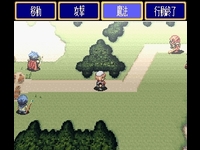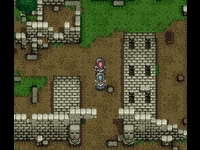|
|

|
PLATFORM
|
SNES
|
BATTLE SYSTEM
|

|
INTERACTION
|

|
ORIGINALITY
|

|
STORY
|

|
MUSIC & SOUND
|

|
VISUALS
|

|
CHALLENGE
|
Easy
|
COMPLETION TIME
|
20-40 Hours
|
|
OVERALL

|
+ An early means of tactical battling that hasn't been replicated
+ Very accommodating with action order
- Limited view of the surroundings
- Infrequent save points
- Repetitive soundtrack
- Antiquated interface
|
Click here for scoring definitions
|
|
|
Most gamers outside of Japan are familiar with the Albert Odyssey series only from its Saturn side story Legend of Eldean, the only title that saw release across the Pacific. The Albert Odyssey series had been established several years prior to that game's release, however, and its inaugural installment bears almost no resemblance to that with which Saturn players would become familiar. The original Albert Odyssey looks like a tactical game using a blueprint that would never be used again, and while in some ways playing it is a fascinating novelty, in others it becomes clear that Sunsoft would have done well to refine the experience for the future.
Fittingly, the beginning of the Albert Odyssey series stars a young man named Albert. He shows up at the beginning of the game to aid young magician Sofia, whose mother was slain by the evil wizard Oswald ten years before. Character development was not a mandatory component of RPGs in 1993, and Albert Odyssey has almost none of it. Beyond Albert and his compatriots being good and the minions of Oswald being bad, the plot receives minimal attention. Even by the standards of the time this is a pretty bare bones affair, but at least that makes importing the game very easy, since understanding the events onscreen will not challenge the mental processes of anyone.
Once Albert exits the first town of the game, his surroundings resemble a tactical RPG. Albert and his allies march around the world map, killing the enemies that bar their passage, in order to enter new towns that will divulge additional scraps of narrative. A few of the enemies might eventually reappear, but for the most part their deaths are permanent. Killing enemies (and only that) gains experience for each character, and the difference between each level is significant enough to make every gain very important.
Aside from the entire game map being one gigantic battlefield, a big difference from the usual tactical RPG presentation comes in the hexagon style of combat. Each character can aim and face in six directions instead of four, and this allows for a number of stratagems impossible in other games. It also becomes annoying at times because the Super Nintendo directional pad was not designed to accommodate a hexagon shape, though being turn-based means the action is never ruined by this difficulty.
Albert Odyssey is unusual in a number of ways, and the most advantageous of them is the ability to take actions in any order at any time. Using magic or attacking can be done at any time, and the game will only force a character to stop moving once that person's movement has been used, no matter how many other actions have been performed prior. Characters are not even limited to choosing between a physical attack or a magical strike, since the game will allow both to be used with each turn. Such flexibility in a game from 1993 is unexpected, but quite welcome.
 Roads? Where we're going, we don't need roads.
Roads? Where we're going, we don't need roads.
|
|
Far less welcome is the fairly rigid visibility the game allows while monitoring the map. Should one wish to scan the landscape far ahead of the protagonists in an effort to identify forthcoming hazards, the interface will disallow this by simply stopping the movement cursor a certain distance from whatever character it was last used by. This is particularly bothersome if the protagonists have become separated by a sizable distance, as control must be switched to another character via a separate menu if the span is so great that the persons are beyond the range of visibility. Constantly limiting the area available to see, especially when the whole of the game's world is usually the battlefield, is quite troublesome.
Covering the entire world on foot also means that, on occasion, characters will need to go back to a previously-visited location for something. Sofia can do this with ease, having a teleportation spell. Other characters can use an item purchased in the locale for the same purpose, but if they don't have one, it's time to walk. Though a few enemies will reappear after the protagonists have vacated an area, zipping through zones already cleared is still a rather dull affair, one that, unfortunately, will often be necessary.
Related to the size of its world is the fairly limited save system of Albert Odyssey. In 1993, being able to save anywhere was not a common occurrence, thus blaming the game for what was common practice is unfair. However, only by putting a character into a town is it possible to save progress in this game, and doing so often requires either a great deal of backtracking or some sizable patience.
Another aspect of RPGs that was far from universal in 1993 was the ability to scan shop inventories to see how their contents compared with equipment currently being used. That facet is lacking from Albert Odyssey, forcing players to buy things in the hope that characters will be able to use them. More bothersome is an aspect of Albert Odyssey far less common, however: the sheer amount of time choices require. The most egregious offense comes when the player cancels moving a character and the entire movement path is slowly retraced, but for some reason the game is also afflicted with slowdown, which is no more welcome here than in any other title. One other aspect is peculiar to the SNES, and it is the choice of Sunsoft to make characters spin around in glorious Mode 7 every time they move. This spinning has the potential to physically repulse some of those who might be interested in the game, probably not the intent of the developer.
 "Sir, was it wrong of me to ignore what that Smokey bear said?"
"Sir, was it wrong of me to ignore what that Smokey bear said?"
|
|
Albert Odyssey is mostly not a difficult game, since enemies will only move when characters approach a set zone. This makes it easy to take a methodical approach most of the time, except that a few enemies use instant death magic with a high likelihood of success. Even this can be counteracted with healing magic or items, however. Advancing with caution and promptly healing maladies is enough to eke out a success.
Among the SNES visuals of 1993, Albert Odyssey doesn't stand out. It has a pretty good variety of enemies, but the landscapes start to become boring long before the game is over, and the only change from the overworld arrives in a couple of caves that are even less visually stimulating. As for the soundtrack, Naoki Kodaka would reuse a few of the themes in this game for the sumptuous music of Legend of Eldean. Unfortunately, the town themes are overshadowed by the length of time spent listening to the boring march of the world at large, and that composition is accorded roughly fifty times more exposure than it warrants.
Most of the original Albert Odyssey is more interesting to describe than to play. While quite original at the time, its numerous small setbacks add up to make for a monotonous experience. Anyone tantalized by the prospect of investigating the series' roots will find an easy import, especially since the few item puzzles are solved with the help of GameFAQs, but there is no translation even after almost twenty years, limiting the appeal to hardcore importers. Even among that crowd, there are plenty of options I'd recommend before this one.
Review Archives
|









